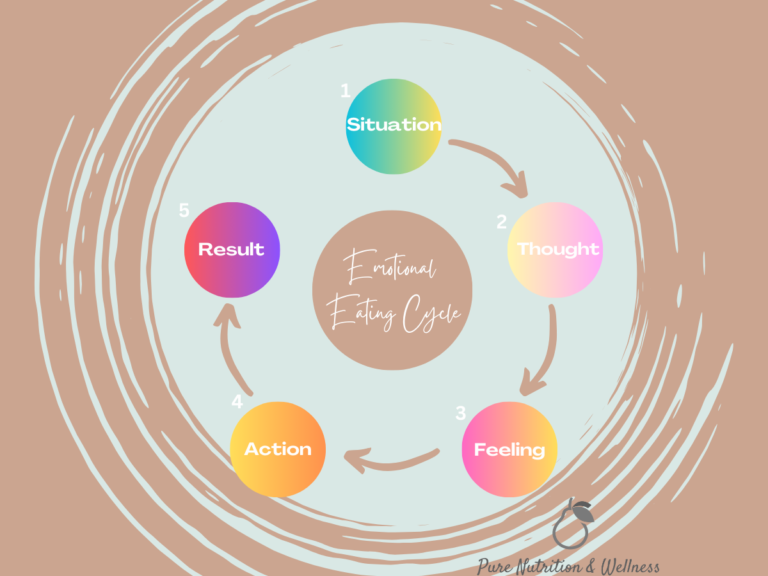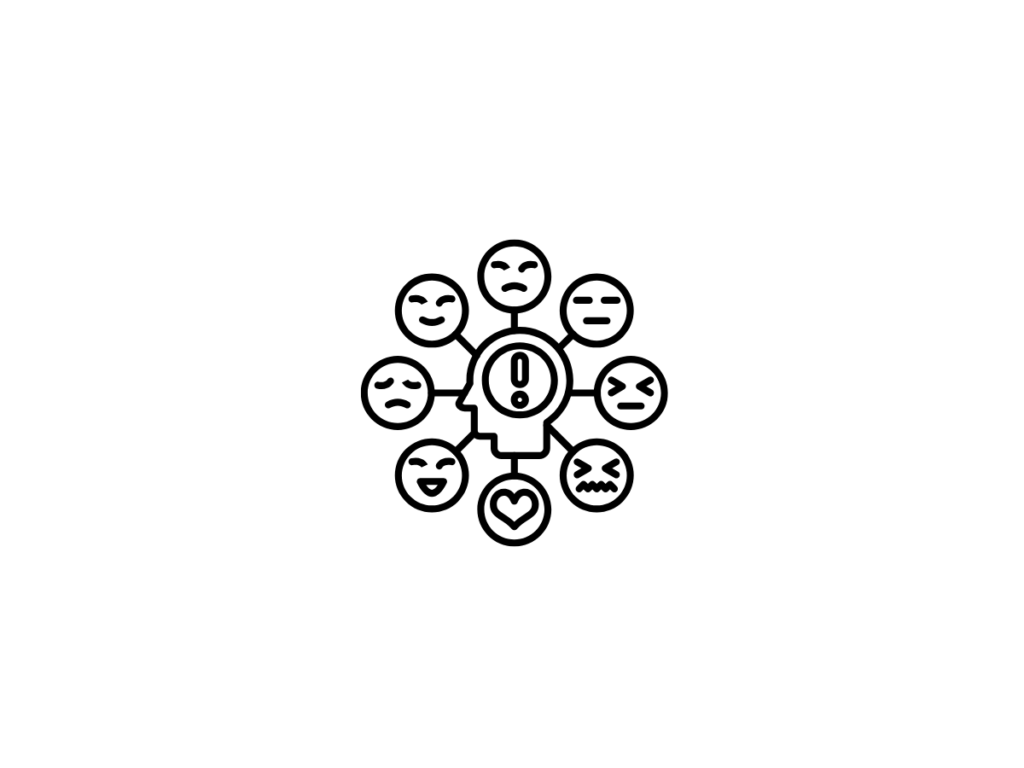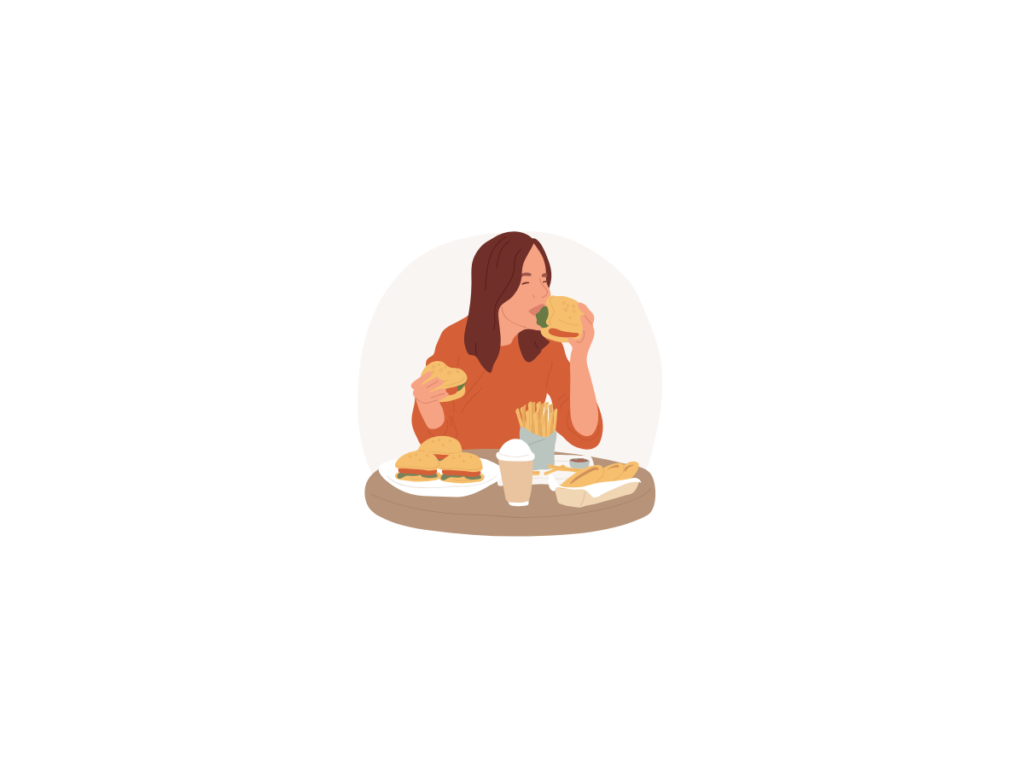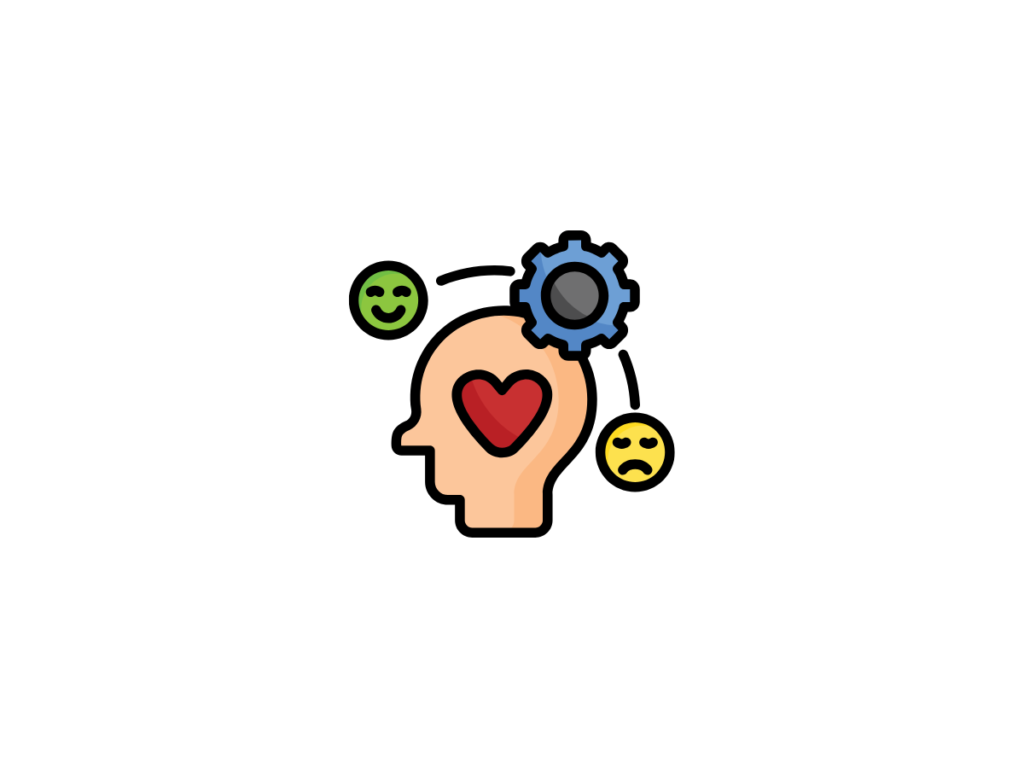
Emotional eating is a common struggle faced by many, often leading to a cycle of overeating that can be hard to break. If you have a goal to lose or manage weight, it’s important to recognize this pattern, understand its triggers, and develop skills to break the emotional eating cycle. In this blog post, we’ll explore the emotional eating cycle and offer insights on how to regain control.
What is Emotional Eating?
Emotional eating is not a medical diagnosis, but it is a common eating behavior that includes the practice of consuming food for reasons other than physical hunger. This eating pattern often arises from feelings such as stress, sadness, boredom, or even happiness that cause individuals to turn to food for comfort, distraction, or relief.
Understanding the Emotional Eating Cycle

1. Trigger / Situation
The emotional eating cycle begins when a particular situation or circumstance triggers a thought. A variety of situations, both positive and negative, can induce emotional eating. Often these situations are beyond your immediate control.
- Vacation
- A fight with your significant other
- Drama at work
- A slow car in front of you
- A messy house
- A report that needs to be written
- Pants that feel too tight

2. Thought
The second step of the emotional eating cycle is a thought. According to the experts at the National Science Foundation, we have approximately 60,000 thoughts per day, and 95% of them are subconscious, repetitive thoughts. That means we are not even aware of what we are thinking, yet our subconscious thought can drive us straight to the cookie jar.
- This vacation is going by too quickly
- My husband isn’t dependable
- My boss is the worst
- This guy doesn’t know how to drive
- My kids are slobs
- I’m so bored, I don’t want to do this
- I look fat
3. Feelings or Emotions
Thoughts lead to emotions, and sometimes those emotions can be intense.
- Anxiety
- Disappointment
- Frustration
- Rage
- Overwhelm
- Boredom
- Embarrassment
Everyone experiences a wave of emotions throughout the day, and sometimes very intense feelings or emotions can become overwhelming and lead to a desire to escape, avoid, ignore or numb them with food. The goal of breaking emotional eating patterns is not to stop intense emotions from happening, but to learn skills to manage them so they do not lead to unwanted eating.

4. Action
Intense emotions guide us to take action to avoid feeling the discomfort associated with the emotion. Many people turn to food or drink to alleviate these emotions. The act of emotional eating falls in this stage of the cycle.
- Drinking a glass or two (or more) of wine
- Eating mindlessly or binging on highly processed snack foods
- Eating large quantities of comfort food
Initially, eating may provide a sense of relief or comfort. This can reinforce the behavior, creating a false sense of control or happiness. However, this relief is often short-lived and can lead to feelings of guilt or shame afterward.
5. Result
Results of emotional eating can range from the physical discomfort of overeating to guilt and shame after a binge, to unwanted weight gain over time.
Once the temporary relief fades, many experience a backlash of guilt and shame for using food as a coping mechanism. This emotional aftermath can further intensify negative feelings, leading to a desire to eat again as a way to cope with the guilt, thereby restarting the cycle. Emotionally eating once in awhile is unlikely to cause weight gain, but when overeating due to buffering emotions becomes a habitual pattern, weight gain often ensues.
Breaking the Cycle
Recognizing and breaking the emotional eating cycle requires mindfulness and intentionality. To mitigate emotional eating, you will need to put a break somewhere in the cycle before the emotional eating occurs. Here are some strategies to help you regain control:

Identify Triggers
Keep a journal to note when you feel the urge to eat emotionally. Document what emotions you are feeling, the context of the situation, and what you reach for. This awareness can help you identify patterns and triggers so that you can avoid triggering situations or at least be ready for them.
Practice Though Shifting
It’s common to place your energy on breaking the emotional eating cycle at the action stage (in other words, targeting the eating portion of the cycle) by using willpower to just avoid certain foods. But you already know that doesn’t work. That would be like trying to weed a garden by chopping off the top of the weed and leaving the root. It might look like it’s working at first, but inevitably the weed grows back. Your thoughts are like the root of the weed. If you really want to break emotional eating patterns, you have to address the root.
Begin noticing the thoughts you’re having that lead to intense emotions. Journal about what you are saying to yourself just before you engage in emotional eating.
Once you’ve identified unhelpful thought patterns, begin to question them. Ask yourself if the thought you are having is really true. This is tough because at first, your thoughts will always appear like the truth, so dig deeper and ask yourself “Is this a universal truth? Is it true for everyone all the time?” If the answer is no, then that’s an indicator that you’re dealing with a belief you hold and that’s not the same thing as a truth.
Once you’ve identified your unhelpful thoughts and beliefs, reframe them to something more helpful. This takes practice!


Develop Healthy Coping Strategies
Shifting thoughts won’t always feel like the right thing to do because sometimes we find ourselves dealing with crappy situations and really tough circumstances, so shifting thoughts might feel fake or like toxic positivity. Sometimes we just need to feel the emotions that go along with our challenging situations. Instead of buffering with food, practice allowing yourself to sit with the discomfort of tough feelings and then find alternative ways to cope with difficult emotions. This could include:
- Engaging in physical activity
- Practicing mindfulness or meditation
- Journaling or expressing emotions through art
- Connecting with friends or loved ones
Create a Balanced Relationship with Food
Reframe your thinking around food. Instead of labeling foods as “good” or “bad,” aim for moderation and balance. Labeling foods as bad as a two-fold effect on emotional eating. First, when a food is labeled “bad” we inherently think we shouldn’t eat it. Our brains are like rebellious teenagers, drawn toward that which is “forbidden”. The very idea that it’s bad and off limits makes us crave it all the more.
The second effect of labeling food as bad happens when we inevitably eat the food, and make the leap in logic (often subconsciously) that we are bad for eating said food. That produces negative emotions like guilt and shame. We wonder what’s wrong with us, and we look for more comfort foods to soothe the negative emotions that eating the forbidden food created in the first place. It’s a vicious cycle. Allowing yourself the freedom to enjoy food without guilt can help reduce the emotional weight attached to eating.
Practice Mindful Eating
Mindful eating is the practice of training your mind to become fully aware of physical sensations, thoughts and feelings during eating. This awareness allows you to truly enjoy your eating experience while also differentiating between physical hunger and emotional hunger. With a mindful eating practice, there is no judgment placed on the decision to eat outside of physical hunger, it’s just about brining awareness to why you are eating and how that food is making you feel.
To eat mindfully, focus on being present during meal times. Slow down and savor each bite, paying attention to your hunger cues and the taste of your food. Put away your electronic devices, work, or anything that distracts you while eating. This practice can help you reconnect with your body and differentiate between emotional and physical hunger.
Seek Professional Support
If emotional eating feels overwhelming, consider reaching out to a dietitian, therapist or counselor who specializes in eating behaviors. Professional support can provide tailored strategies and tools to help you navigate your emotions and learn how to eat in a way that nourishes your body and soul.
Looking For Support to Make Healthy Changes?
Breaking the emotional eating cycle is a journey that requires patience and self-compassion. By understanding the triggers and emotions that lead to this behavior, you can start to implement healthier coping mechanisms. Remember, it’s okay to seek help, and every small step you take is a move toward a more balanced relationship with food and your emotions. To get expert guidance on your journey to a healthier relationship with food, reach out to Pure Nutrition and Wellness for a free consultation or learn more about our Emotional Eating Course to guide you in developing the skills you need to beat emotional eating.
